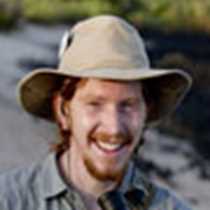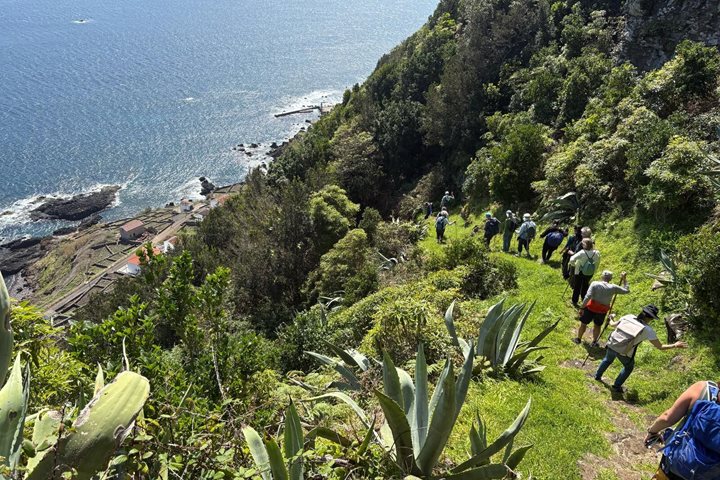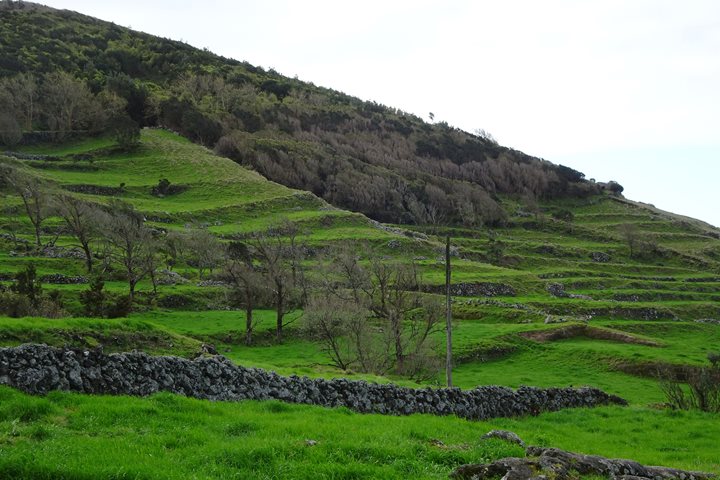Our second full day in the Madeira Islands proved to be a truly spectacular experience from dawn to dusk. Typical Madeira weather and conditions began the day, 15°C before sunrise a light breeze and as the sun broke the horizon by 0730 dimming the lights of the picturesque port of Funchal we prepared for another day in this island paradise. Today there were two options of exploration here, the first being an outing to walk in the “fossil” Laurissilva or Laurel forests including a stop at the summit of Pico Arieiro to take in the spectacular volcanic landscape. A second outing visited the botanical gardens here, showcasing the diversity of plant life that can grow in this stable sub-tropical climate with a visit to the more arid eastern side of Madeira and a chance to learn about the whaling history of Madeira at the whaling museum.
As author of this chapter about or expedition I will focus mainly on the first of our two options. We wound our way up the incredibly well-engineered, but narrow, mountain roads passing through various landscapes with breathtaking views at nearly every switchback, ultimately arriving at the summit of Pico Arieiro at over 1800m. From sea level one cannot truly appreciate the shape and magnificence of this volcanic gem in the middle of the Atlantic, however from a vista such as this the rugged, at times stark, and awesome landscape unfolds leaving one to ponder the processes, geological and biological that shaped this world. Having taken in as much as we could we descended some 500m to the elevation zone where the fabled forest community that gives this island its name reaches its highest altitude. The Laurissilva or Laurel forest that once carpeted most of the islands of Macaronisia, including the Azores, Madeira, and Canary Islands now exists only in remnant patches and in many places has long been eradicated for lumber and agriculture over the centuries. Here on Madeira remains one of largest single intact stands of this unique ecosystem that over 100 million years ago carpeted most of Europe and North Africa, which is where the term “fossil” forest stems from. The forest itself is comprised of hundreds of species, many of them endemic to Madeira. Our hike took place along one of the dozens of levadas, manmade watercourses used to bring water down from the moist mountain forests to the more dry communities and farms below. One true highlight for those “binoculared” birdwatchers in the group was to get very good looks at two endemic species of birds, the first being the Madeira Firecrest (Regulus madeirensis) and the Trocaz, or Madeira-Laurel, Pigeon (Columba trocaz). Our hike ended at the “Balcoes” or Balcony overlook giving splendid views of the montane forests. A classic Madeira-style lunch was had in the small, forested community of Poiso before returning to the ship for the afternoon’s activity.
Located to the east and just south of the main island of Madeira are the Islas Desertas where we spent the afternoon exploring by Zodiacs the barren but incredibly striking volcanic island. If that was all that happened this afternoon we would have been quite happy, however we were in for a truly incredible spectacle almost beyond words. Our short passage over to the islands was interrupted when from the bow and bridge several dorsal fins were spotted in the distance resting at the surface. We approached slowly and once close enough the naturalists on the bridge conferred that we were looking at a group of short-finned pilot whales (Globicephla macrorhynchus) resting at the surface. These whales are found throughout the mid-latitudes and are often quite cooperative around ships. This as it turns out would only be the beginning of our encounters with marine mammals this afternoon.
Our Zodiac cruise along the sheer volcanic shoreline of Dersertas was spectacular; the myriad of colors, and textures towering over our heads mirrored in the calm deep blue waters was quite a setting. As we neared the end of our cruise a call from the bridge had informed us that there were dolphins and some baleen whales very near the ship. Another radio transmission from a Zodiac announced that the rare and highly endangered Mediterranean monk seal, known to occupy these waters, was spotted. We had to make a choice. I had decided that our chances of seeing and interacting with the dolphins would be a better use of our remaining time, my passengers on board agreed. So I turned the Zodiac in the direction of the masses of seabirds and splashes from feeding dolphins about a mile or so away. Soon enough we were surrounded by dolphins of two species, Atlantic spotted (Stenella frontalis) and common bottlenose dolphins (Tursiops truncates). Some riding the bow wake while others leaped out of the water along either side. Though it was just for a few moments the thrill of seeing these animals up close lasted far longer.
After all the Zodiacs returned to the ship our galley crew and hotel department had prepared a special treat on the sundeck, fresh tuna sashimi and wine. That was not all we were treated with as it turned out. The Captain announced that we'd be sailing into what he called, “whale and dolphin stew.” Sure enough in a matter of minutes we were surrounded by no less than five species of cetaceans feasting on the abundant food stirred up by the currents ripping through the islands and sea stacks. Dolphins performed their incredible acts as they rode the bow wake, leaping, spinning and the like, Sei (Balaenoptera borealis) and Bryde's whales (B. edeni) lunging out of the water, their ventral pleats enlarged and full of fish. In the distance several sperm whales (Physeter macrocephalus) plied the waters, their angled tell-tale blows revealing their presence. The show went on for over an hour as we made way towards our next destination in Macaronesia, The Canary Islands of Spain.









